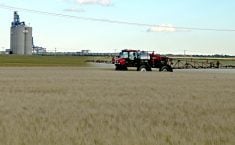Two major trade issues confronted producers in 2008 – one fizzled and one bit with a vengeance.
The World Trade Organization’s Doha round fizzled as countries spent a fruitless year searching for a way out of their impasse.
Canadian farmers who support orderly marketing continued to pressure the government not to agree to a deal that threatened the Canadian Wheat Board and supply management, while more export-oriented producers pushed for a deal that opened markets.
An agreement appeared imminent in spring and WTO members sent representatives to Geneva in July to seal the deal. However, they returned home empty-handed, largely because China and India refused to accept restrictions on their ability to use temporary tariffs to limit food import surges.
Read Also

Frost-free season lengthens this year
Saskatoon, Edmonton, and Dauphin saw their frost-free season range from 131 to 135 days, which is about 15 to 20 days longer than average.
A failed October meeting was followed by failed attempts at organizing a December meeting. Some trade officials now say it might be better to start new talks from scratch.
Country-of-origin labelling, or COOL, had better success in the United States, but rose to bite many Canadian producers and processors.
U.S. lawmakers passed legislation making COOL official in May. Canada’s livestock sectors, especially cattle and pigs, protested the law as being protectionist and designed more to keep foreign competition out of the U.S. than to help consumers identify homegrown products.
When the law came into effect Sept. 30, the effects on Canadian exports to the U.S. were felt almost immediately as feeders and packers there bought animals at significantly lower prices, if at all, and retailers sold Canadian meat for less than American product.
In late November, the Canadian government announced plans to challenge COOL at the WTO.
Railways moved lots of grain in 2008, made lots of money and spent lots of time defending their performance.
Canadian National Railway found itself on the losing end oftwo service complaints launched by grain shippers.
In January, the Canadian Transportation Agency ruled the railway failed to live up to its service obligations to six shippers, including the Canadian Wheat Board, in the 2006-07 crop year.
In September, the agency ruled the railway failed to provide adequate service to four shippers during 2007-08 and set out new performance benchmarks.
The agency dismissed complaints by two other shippers, including the CWB.
The board appealed the decision to the Federal Court of Canada.
The year began with news that Canadian Pacific Railway had exceeded its 2006-07 revenue cap of $433.3 million by $3.76 million, the maximum amount it can earn from hauling grain.
It was ordered to pay a $3.08 million penalty to the Western Grains Research Foundation. CN was slightly under its cap.
In February both railways reported higher profits for 2007, with CN earning $2.16 billion and CPR $946.2 million.
Later that month, the CTA announced it would reduce the 2007-08 revenue cap by $72 million, or about $2.50 a tonne, to more accurately reflect hopper car maintenance costs. The railways were being paid $105.1 million a year, while actual costs were $32.9 million. Railways are considering a Federal Court appeal.
The government passed legislation making it easier for shippers to challenge railway fees and launch service complaints. It also announced a rail service review that would cover all commodities.
Grain shippers released a report saying railways were being overpaid $100 million annually.
The Oct. 14 federal election that returned a second consecutive and strengthened Conservative minority government also unleashed a period of political instability and drama unprecedented in Canadian history.
The next stage in the saga is expected to play out in late January or early February. Liberals under new leader Michael Ignatieff will decide whether to team up with New Democrats and the separatist Bloc Québécois to topple the government in hopes that the governor general will ask them to form a coalition government.
If Michaelle Jean refuses, defeat of the Conservatives could lead to the fifth federal election in little more than eight years.
Conservative leader Stephen Harper became the first prairie-based political leader to win consecutive national governments in half a century. Harper was returned to government with 143 seats, 12 less than his hoped-for majority but 19 more than 2006.
Liberal leader Stéphane Dion quickly announced he was stepping down to become the second Liberal leader in the party’s almost 140-year history not to become prime minister. He was the party’s 11th leader.
As Canada sank into recession in November, the newly elected, Harper government took several missteps that led opposition leaders to formally agree to a Liberal-NDP coalition supported by the BQ. Harper avoided a vote that could have overthrown his government by getting Parliament suspended until Jan. 26, when the government will unveil a throne speech and then a budget.
Ignatieff, elected leader by the Liberal caucus and party elders in December, will have to decide at the end of January whether to defeat the Harper government or allow it to continue.
The Canadian biofuel industry ended a difficult year on a positive note when ethanol capacity reached one billion litres.
It also began in a promising way with oil breaking the $100 US a barrel mark Jan. 2, making the case for biofuel “crystal clear,” according to the Canadian Renewable Fuels Association.
Sandwiched between those two bright spots were a public relations nightmare, legislative triumphs, extreme price volatility and the opening of biofuel plants.
By far the biggest story of the year was the food versus fuel debate, a campaign launched by food manufacturers and feed users and supported by humanitarian groups that blamed biofuel for driving up food costs.
Jean Ziegler, the United Nations special rapporteur on the right to food, said it was a “crime against humanity” to convert crops into fuel and called for a five-year moratorium on grain-based ethanol production.
The campaign tarnished what until then had been biofuel’s shiny image and sparked calls in the U.S. to roll back mandates.
In the midst of that hostile environment, the Canadian government passed Bill C-33, paving the way for mandates of five percent ethanol and two percent biodiesel by 2010 and 2012 respectively.
Throughout 2008, price volatility created a challenging operating environment. Margins were squeezed by record corn, wheat and canola prices, which were partially offset by sky-high oil prices. By year’s end, however, oil had fallen to about $40 per barrel.
Companies such as VeraSun Energy Corp., the largest producer of ethanol in the U.S., were forced to sell low-priced fuel made from high-priced corn and forced into bankruptcy.
Despite difficult times, four ethanol plants opened for business in Canada, adding a combined 630 million litres of production capacity. One 19 million litre biodiesel plant also began operations.
By the end of the year, biofuel promoters were pointing out that crop prices had tumbled but food prices hadn’t, supporting their claim that high oil prices and market speculators had been the real cause behind the run-up in food costs.
The Canadian wheat board found itself in controversy despite earning record revenue of $7.7 billion during the crop year that ended July 31, 2008.
Australian Ian White became the new chief executive officer March 31, while Larry Hill replaced Ken Ritter as chair. Ritter resigned in April after nine years in the position.
The CWB won two important court decisions. The Federal Court of Appeal upheld a 2007 lower court ruling that the government requires legislation to change the marketing system.
The Federal Court also ruled that a gag order imposed on the board in 2006 was illegal. Ottawa has appealed that decision.
Prime minister Stephen Harper responded by saying anyone who tried to block the government from getting rid of the single desk would be “walked over.”
In CWB director elections, pro-single desk candidates won four of the five seats, enabling single desk supporters to retain an 8-6 majority on the board of directors.
A listeriosis outbreak killed 20 people and made another 30 seriously sick. The Canadian Food Inspection Agency came under fire for its handling of the situation.
The disease was traced to processed meats from a Toronto Maple Leaf Meats plant. The company was forced to close the plant in August and recall almost 200 products after the bacterium Listeria monocytogenes was found.
Maple Leaf later announced it would pay $25 to $27 million to settle a class action lawsuit on behalf of the families of those who had died or those who were sickened by eating the meat.
The agreement had yet to be approved by courts at press time.
The outbreak also played a role in the campaign for the Oct. 14 federal election, when agriculture minister Gerry Ritz said during a conference call that the daily news of illness or death from the outbreak was for the government “death by a thousand cuts, or should I say cold cuts.”
Despite the controversy, Ritz was re-elected and was reappointed to the federal agriculture minister’s post.
The Agriculture Union of the Public Service Alliance of Canada, the union that represents food inspectors, urged that it be notified when tests for listeria and other bacteria are positive. It said staff reductions had affected the ability of inspectors to do their jobs and it charged that the CFIA took too long to notify the public.
The CFIA and the federal government are conducting reviews.
A survey in early December by the University of Guelph in Ontario of 2,000 people reported that the number of people who never consumed ready-to-eat meat products at home jumped to 39 percent after the outbreak from six percent before.
Maple Leaf’s Toronto plant has since reopened with more stringent inspection and sanitary measures.
Problems in the hog and cattle sector continued, spurred on by a high Canadian dollar, volatile grain prices, a lack of access to international markets and the limited number of packer options.
The industry was also challenged by country-of-origin labelling in the U.S. and a push for mandatory age verification, seen as a way to do more business with overseas markets. COOL sent a chill through the U.S. packing and feeder industry, convincing packers and feeders to avoid Canadian animals for fear of fines and penalties.
Ethanol also affected the cattle and hog industries by keeping feed prices high, but the generally stronger Canadian dollar through the first half of 2008 kept feed costs lower. However, it also kept North American hog prices lower in Canadian dollar terms.
In recent months, hog prices haven’t fallen as much in Canada because of the decline of the Canadian dollar against American currency.
Hog herd numbers continued to shrink in North America, especially in Canada. Producers struggled with high feed prices and inadequate hog prices last spring, forcing them to rack up losses and liquidate their herds.
The major herd reduction is expected to lead to better prices and greater optimism that break-even is possible now that feed prices are falling.
Increasing production costs came hand in hand with higher grain prices.
Rocketing oil prices, to a peak of more than $140 per barrel in July, double what they were 12 months earlier, caused diesel and gasoline to rise in step.
Livestock producers saw the cost of feed grain rise.
Globally, farmers chased higher grain prices by seeding more acres and applying more fertilizer.
Fertilizer makers saw a chance to price their product at what the market would bear.
In Alberta, a tonne of 46-0-0 urea climbed to $935 in October, up 76 percent from the previous year.
Diammonium phosphate 11-51-0 climbed to $1,328 per tonne, up 121 percent from 2007.
Alberta farm gasoline rose to $1.03 per litre in October, from 84 cents in 2007. Farm diesel rose to $1.04 from 75.4 cents the year before.
Grain prices began to crash in September, but some experts still expected inputs to hold steady or rise. However, energy and nutrient demand plunged, knocking the supports from fuel and fertilizer and their prices began to fall. The problem was that North American fertilizer dealers had bins full of product at the high summer price.
It took months, but retail prices of nutrients are starting to fall.
Price highs sparked elation for grain farmers as wheat, canola and special crops soared to record levels, and then, disbelief when the bottom fell out of the market.
Spring wheat on the Minneapolis exchange and canola in Winnipeg peaked in February.
Other crops peaked in July. But since then prices have plunged 50 percent or more.
The runup was caused by a rare coincidence of several factors including disappointing crops in Australia and elsewhere, rising food demand, a bullish investment outlook for commodities and rising energy prices.
But then the sub prime mortgage crisis in the United States rippled through the world economy. Investors’ losses rose, forcing them to sell their commodity investments to generate cash.
This caused agricultural markets to plunge.
End users of agricultural products slowed their buying because, in a falling market they could meet their needs more cheaply by waiting.
Also, the economic chaos threw most of the developed world into recession, reducing employment and making consumers nervous. Demand slowed.
Analysts now believe markets have established a floor and grain prices might strengthen a little, particularly if dryness persists in South America.
However, a significant rally is considered unlikely until the global economy improves and that might not happen until late 2009 or 2010.
The prairies experienced strong growth in 2008.
Boom times ratcheted up spending even as house and land prices soared in towns and cities and people borrowed ever-greater amounts of money.
However, it appears the correction for such excesses and imbalances is on its way and it’s unlikely the Prairies will miss out.
Exporters anxiously watched the dollar strengthen through the year to better than par against the American dollar before dropping as fall approached, settling in around 81 cents by year’s end.
Experts say the plunging loonie will probably help Canada weather a global economic slowdown by making exports more competitive.
Canada’s manufacturing sector suffered as the dollar soared. The strong dollar made Canadian-produced goods relatively more expensive and hurt export-based industries, particularly the auto and forestry sectors, which have lost thousands of jobs.
Alberta’s oilsands projects became less attractive because of major environmental concerns, escalating costs and a sudden drop in oil prices.
Major auto makers went looking for a deal from Ottawa to salvage their industry.
The S&P/TSX composite index plunged by 42 percent between Sept. 26 and Nov. 25.
The future is murky, with little known about how long and how deep the recession will be.
What is clear is that Canadians’ personal wealth, home values, investments and RRSPs are falling and the bottom is not yet in sight.
















